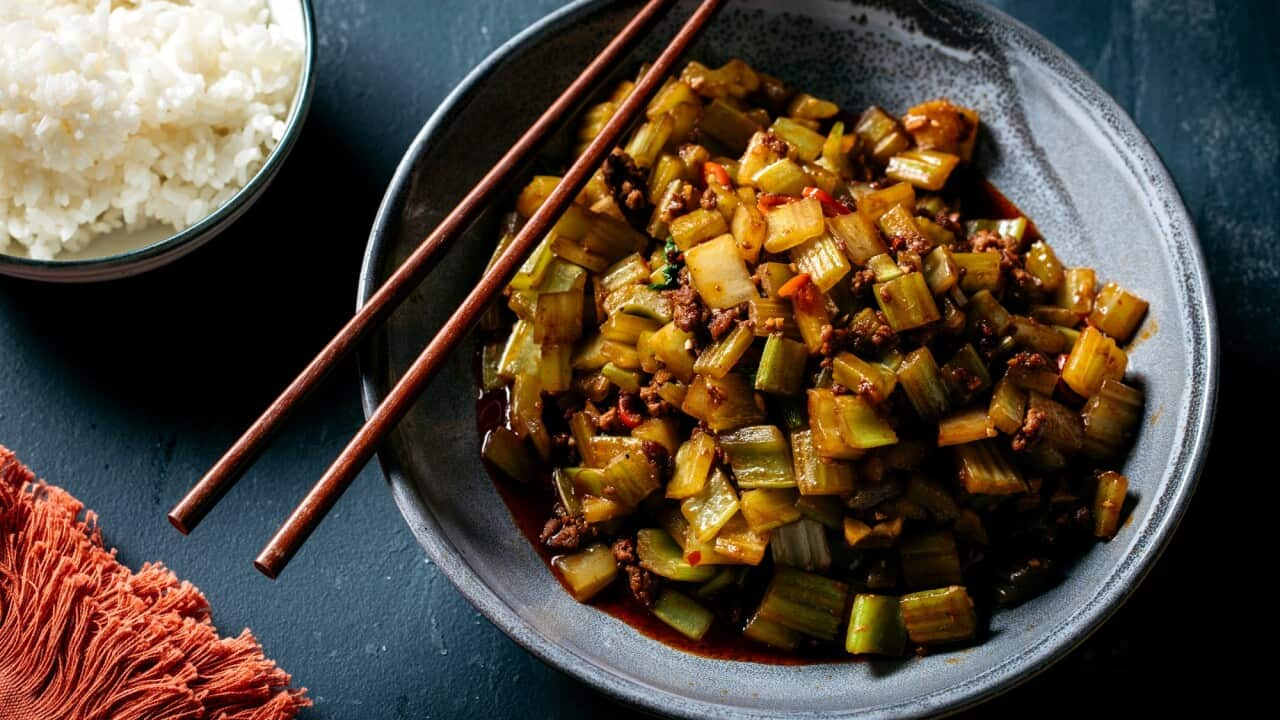--- 's airs weeknights on SBS Food(Ch.33) at 7.30pm. All episodes available anytime on SBS On Demand. ---
If you've ever tried to replicate the taste of your favourite Asian restaurant but found yourself falling short, you may need to brush up on your wok hei. Wok hei is Cantonese for "wok breath", which basically captures the smoky, charred energy needed for true wok cooking flavour.
To achieve wok hei, celebrity chef and food icon Elizabeth Chong, says to "heat your wok up first so that it's breathing, and that's the breath of the wok. Then when you wok-toss your meat, it gets that smokiness that comes from the wok... The wok is breathing. It's alive."
If you want a wok that's brimming with life, first you need to seal it and then you need to maintain it. That's because without the correct seasoning, you'll never capture true wok hei.
First season
When you first buy your wok, the first thing to do is give it a good wash with a mild detergent using a non-abrasive brush. Once you're confident your wok is spotlessly clean and dry, set it on the stove. At this stage, if your wok has wooden handles, it's a good idea to wrap these firmly in aluminium foil to protect them from scorching. Things are going to get hot, hot, hot.

If you season your wok properly, getting an authentic char on your char kway teow is a cinch. Source: Adam Liaw
Crank the heat up and wait until your wok starts to smoke; this means any residual oil from the manufacturing process is burning off. Tilt your wok around to evenly heat your wok all over and ensure every bit of the oil burns off. Depending on how hot your stove runs, this may take a bit of time. If your wok is made of carbon steel, you'll know you've done the job when your wok turns an enticing shade of blue. Otherwise, assume you're ready after a few minutes.
Drop the oil
Next, keep the heat high then carefully add a drop or two of oil. Be careful not to add too much, says The Cook Up host and wok-master Adam Liaw. "Where people always go wrong... is they add far too much oil and they leave far too much oil in the wok."
"The wok is breathing. It's alive." - Elizabeth Chong
So, just a bit of oil; enough to evenly coated the entire wok when you tilt and rotate it around, but no more (be careful not to light it on the flame below). Once the entire wok is covered, turn off the heat and use a paper towel to wipe out the wok. Make sure you use enough paper towel to protect your hand, or wear heat-proof gloves, as the wok will still be super hot. Keep wiping until you've removed every bit of excess oil.
Burn baby, burn
Once you've only got a sheen of oil all over the wok, return your wok to high heat and, as Adam Liaw advises, "burn the heck out of it." Things will be smoking, so ensure your exhaust fan is running high and keep tilting and rotating the wok to ensure the seasoning is even. After a minute or two of smoking-hot wok-hei-ing, wipe the oil clear, then start the process again with another drop or two of oil.
After you've completed this initial seasoning process twice, wipe out all traces of excess oil with a paper towel and your wok is nicely seasoned and ready to fry.

"Seasoning a wok is such an important thing," says Adam Liaw. "If you try and cook in [an unseasoned wok], you are going to stick to it every single time." Source: Getty Images
Every season
The first season is critical, but for good wok hei you'll need to complete a version of the process every time you use it.
This involves cleaning your wok in hot water only - don't use any soap, it will spoil the patina you are working so hard to build. Then you need to get it nice and dry, heat a bit of oil to high heat and swirl it to coat the whole wok. Then wipe it out with paper towel. Once you've wiped it as much as possible, burn the heck out of it again.
After a minute or two of smoking-hot wok-hei-ing, wipe the oil clear, then start the process again.
Adam also advises you to clean your wok as soon as you finish cooking. "I don't leave food sitting in the wok because that can get rid of the seasonings," he says.
Instead, a good habit to get into is rinsing out and drying your wok as soon as you've served your dish. You can then take the time to do the seasoning once you've finished eating and before you do the rest of the cleanup. That way your wok has time to cool completely down while you clean everything else in the kitchen.
Once it's seasoned and completely cooled, pop it away in the cupboard, safe in the knowledge it will be ready to fry next time.
















